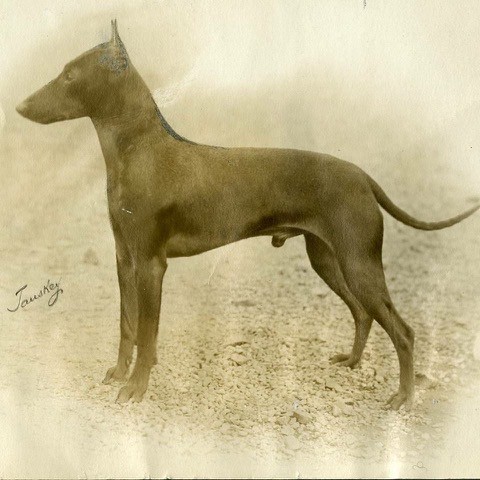... 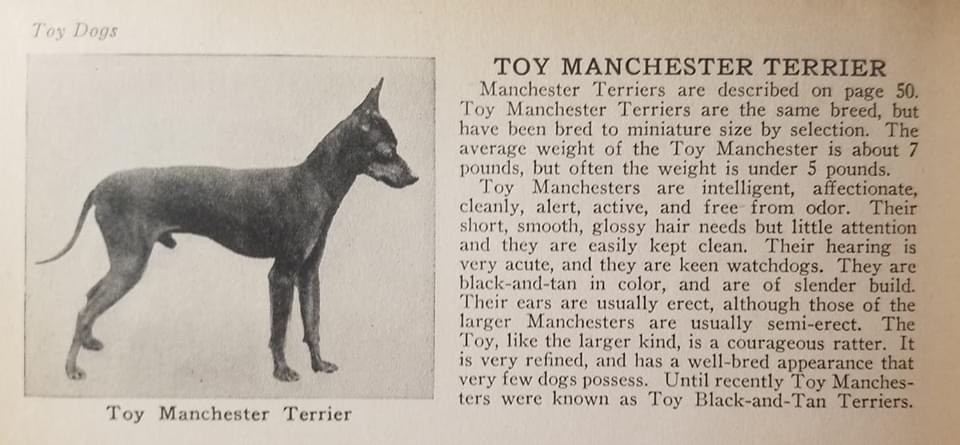
Blog
... Mancheter Terrier
bitte den Ton einschalten.
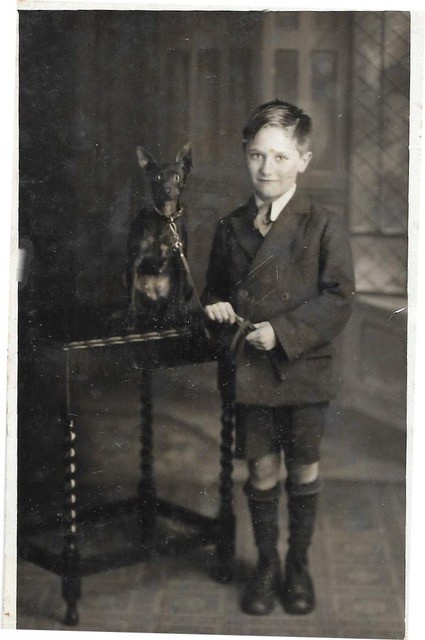
My dad Len Tweed aged about 6 with his beloved dog Rosie . We believe her to be Dandy Rose who won best female puppy in the black and tan breed (as they were called then)at Crufts in 1926. When she died my dads uncle gave him a cup and told him she had won it at Crufts. It was this story that started myself and Marian Moss my cousin on a very unusual family history trek .Marian has done some incredible work on finding out about the Tweed legacy and this breed
FBTweed
Link 1
Link 2
http://www.curious-madcaps.com/blog/Einträge/hunde/jdcm-clearxanthinuria-clear.html

In die Ahnentafel vom Klub für Terrier werden ab sofort zwei NEUE Untersuchungen eingetragen, die auf freiwilliger Basis gemacht werden. Momentan gibt es die Untersuchung nur bei der University of Minnesota.
Xanthinuria Typ 2 a (XU2a) CLEAR(N/N - No copies of the XUa mutation
und
Juvenile Dialatd Cardiomyopathy (JDCM) CLEAR (N/N -No copies of the JDCM Muation
The standard Manchester Terrier and the English Toy Terrier. From the Ruth Kitson Archive
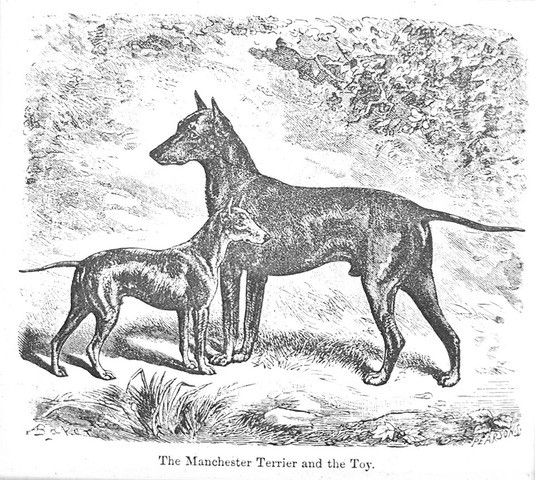
Article about Miss Darbyshire's The General in 1896
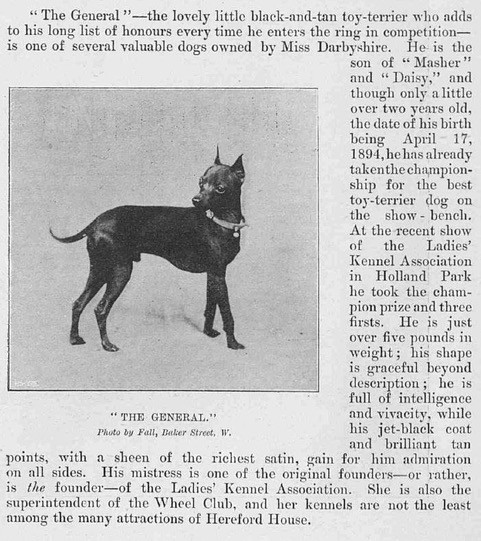
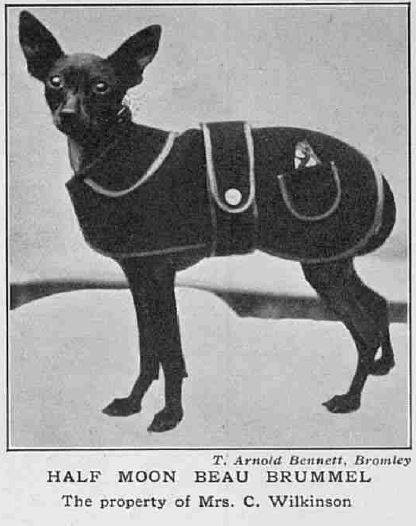
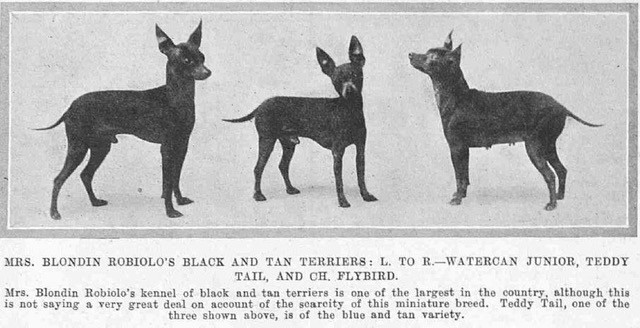
- 1962 wurde der Toy Black and Tan Terrier in English Toy Terrier umbenannt und erhielt so seinen Namen.
- Der Britische Kennel Club öffnete als erster die Grenzen und erlaubte es Manchester Terrier und Manchester Toy Terrier zu importieren, um den Genpool auf der Insel aufzufrischen. Das war auch dringend notwendig, denn durch den engen Genpool hatten sich Krankheiten wie Patellaluxation, fehlendes Haar im Kehl-und Brustbereich, fehlende Zähne usw. manifestiert. Leider gibt es auch heute noch in Deutschland wenig Hunde die nicht miteinander verwandt sind, was unsere Rasse natürlich nicht wirklich weiterbringt.
Um den Genpool unserer Zucht zu erweitern haben wir Jacky aus den USA bei uns aufgenommen.
- Die ETTs (TMT) aus den USA und Kanada sind etwas knochenstärker, haben etwas länger gestreckte Köpfe, sind zumeist vollzahning und waren unbediengt nötig um die Rasse ETTs wieder gesunden zu lassen.
_
unsere Jacky aus USA

Mrs Petronella Kitson with
Ch Quinoa Cold Comfort,
Ch Quinoa Queen Of Spades,
and Quinoa Little Ladyship.
Cold Comfort won 20 CC's, 3rd highest among the ETT Bitches.
Cold Comfort was BOB at crufts in 1983, 84 and 85.
Queen of Spades was BOB at crufts in 1982

FB
SECOND DOG BREED FOR TODAY IS THE ENGLISH TOY TERRIER
The English Toy Terrier - Black and Tan is a small breed of terrier in the toy dog group.
Though it may be tiny, this plucky, clever breed is every inch a “real” dog, just in miniature. The similarity of its appearance to that of the Manchester Terrier is no coincidence, as the two breeds were grouped as one in the United Kingdom until the 1920s, and still are today in the United States, with the English Toy Terrier known as the Toy Manchester Terrier. Its finer bone structure may be the result of some input from the Italian Greyhound, but it has largely retained its larger cousin’s energy, vigour, and courage. As is typical of a terrier, it can demonstrate an aloof and suspicious manner towards strangers, but it is also an extremely lovable and affectionate pet, and makes a great family dog, though it may be a little too small and easily injured to be suitable for the under-fives.
The Kennel Club lists the English Toy Terrier as a vulnerable native breed, meaning that less than 300 puppies are registered by the organisation each year, and so efforts are being made to increase the demand for, and breeding of, this appealing little dog. To this end, Toy Manchester Terriers from the United States can be re-registered as English Toy Terriers in order to grow the breeding population. Such outbreeding, though resisted by some purists, will enhance the genetic diversity within the UK population, and should hopefully help reduce the incidence of several health problems recognised within the breed. However, most English Toy Terriers are very healthy, and have a lifespan of 12 to 13 years.
Growing urban populations in England in the seventeenth century, coupled with poor hygiene, lead to a massive surge in rodent numbers, something that led, in turn, to public health problems. City dwellers therefore found that they needed small terriers with a penchant for killing rodents in order to keep their neighbourhoods and homes habitable, and it was from this necessity that the English Toy Terrier was born. The English Black and Tan Terrier, which is now extinct, belonging to the Fell Terrier class, is most closely related, and was known as a capable vermin hunter. It was mostly likely cross-bred with the Whippet by the early Mancunian breeders to lend it more speed, resulting in a dog that was fast, blood-thirsty, and small enough to comfortably share its owners’ cramped lodgings.
Apart from being a public health necessity, rat baiting became a popular sport for the common man, with proud owners allowing their dogs to be placed into a ring with up to several hundred rats, and then placing bets on how long it would take the dog to dispatch a given number of the rodents. Seen through a twenty-first century lens, this was a cruel practice for all the animals involved, as the dogs themselves often suffered horrific injuries inflicted by the desperate rats. This sport was banned around the time of the Kennel Club’s inauguration in the nineteenth century, but the breed continued to enjoy popularity as a show dog by virtue of its sculpted, elegant appearance. In the 1920s, a growing separation between small and larger specimens was acknowledged by the division of the then Black and Tan Terrier into the English Toy Terrier and the larger Manchester Terrier.
Over the years, the explosion in the importation and popularity of foreign breeds gradually led to a decline in English Toy Terrier numbers, a trend also seen for the Manchester Terrier, and both are now considered vulnerable breeds. While demand for their rat-killing services may no longer exist on any great scale, both are charming, vivacious breeds that are perfectly suitable as pets, and can hopefully be successfully promoted and revived over the coming decades.
Der englische Spielzeug Terrier - schwarz und Tan ist eine kleine Rasse von Terrier in der Toy Dog Group.
Obwohl es winzig sein mag, ist diese mutige, clevere Rasse jeden Zentimeter ein "echter" Hund, nur in Miniatur. Die Ähnlichkeit seines Aussehens mit dem des Manchester Terrier ist kein Zufall, da die beiden Rassen bis in die 1920 er Jahre als eine im Vereinigten Königreich zusammengefasst wurden und heute noch in den Vereinigten Staaten sind, mit dem englischen Spielzeug Terrier, der als Das Spielzeug Manchester Terrier. Seine Feinere Knochen Struktur mag das Ergebnis einiger Eingaben des italienischen Windhund sein, aber er hat die Energie, Kraft und Mut seines größeren Cousins weitgehend bewahrt. Wie es typisch für einen Terrier ist, kann es eine unnahbar und verdächtige Art gegenüber fremden demonstrieren, aber es ist auch ein extrem liebenswerter und liebevoll Haustier, und macht einen tollen Familien Hund, obwohl es vielleicht ein wenig zu klein und leicht verletzt ist, um geeignet zu sein Für die unter-Fünfer.
Der Kennel Club listet den englischen Spielzeug Terrier als eine gefährdete einheimische Rasse auf, was bedeutet, dass jedes Jahr weniger als 300 Welpen von der Organisation registriert werden, und so werden Anstrengungen unternommen, um die Nachfrage nach und die Zucht von diesem attraktiven kleinen Hund zu erhöhen . Zu diesem Zweck kann spielzeug Manchester Terrier aus den Vereinigten Staaten als englische Spielzeug-Terrier neu registriert werden, um die Zucht Bevölkerung zu wachsen. Solche Outbreeding, obwohl sie von einigen Puristen abgewehrt werden, werden die genetische Vielfalt innerhalb der britischen Bevölkerung verbessern, und sollten hoffentlich dazu beitragen, die Inzidenz mehrerer Gesundheitlicher Probleme, die innerhalb der Rasse anerkannt werden, zu verringern. Die meisten englischen Spielzeug-Terrier sind jedoch sehr gesund und haben eine Lebensdauer von 12 bis 13 Jahren.
Die wachsenden städtischen Populationen in England im siebzehnten Jahrhundert, gepaart mit der schlechten Hygiene, führen zu einem massiven Anstieg der Nagetier zahlen, was wiederum zu Problemen der öffentlichen Gesundheit geführt hat. Die Stadtbewohner stellten daher fest, dass sie kleine Terrier mit einer Vorliebe für die Tötung von Nagetieren brauchten, um ihre Nachbarschaften und Häuser bewohnbar zu halten, und es war aus dieser Notwendigkeit, dass der englische Spielzeug Terrier geboren wurde. Der Englische Schwarz-und Tan Terrier, der nun ausgestorben ist, gehört zu der fiel Terrier Klasse, ist am meisten verwandt und wurde als fähiger Ungeziefer Jäger bekannt. Es wurde meist mit dem Whippet von den frühen Respektieren-Züchtern Kreuz, um ihm mehr Geschwindigkeit zu verleihen, was zu einem Hund führte, der schnell, Blut durstig und klein genug war, um die engen Unterkünfte seiner Besitzer bequem zu teilen.
Abgesehen davon, dass es eine öffentliche Gesundheit ist, wurde ratten ködern zu einem beliebten Sport für den gemeinsamen Mann, mit stolzen Besitzern, die Ihre Hunde mit bis zu mehreren hundert Ratten in einen Ring setzen können, und dann wetten, wie lange es den Hund nehmen würde , um eine bestimmte Anzahl von Nagetieren zu versenden. Durch eine-Jahrhundert-Linse gesehen, war dies eine grausame Praxis für alle Beteiligten Tiere, da die Hunde selbst oft schreckliche Verletzungen erlitten haben, die von den verzweifelten Ratten zugefügt wurden. Dieser Sport wurde rund um die Zeit der Einweihung des Kennel Clubs im neunzehnten Jahrhundert verboten, aber die Rasse hat die Popularität als Show Hund nach ihrem geformt, eleganten aussehen weiterhin genossen. In den 1920 er Jahren wurde eine wachsende Trennung zwischen kleinen und größeren Exemplaren durch die Division des damals schwarzen und Tan Terrier in den englischen Spielzeug Terrier und den größeren Manchester Terrier anerkannt.
Im Laufe der Jahre führte die Explosion bei der Einfuhr und Popularität ausländischer Rassen allmählich zu einem Rückgang der englischen Spielzeug-Terrier-Zahlen, ein Trend, der auch für den Manchester Terrier gesehen wurde, und beide werden jetzt als gefährdete Rassen betrachtet. Während die Nachfrage nach ihren Ratten-Tötungs Diensten nicht mehr in großem Maßstab existieren kann, sind beide charmante, lebhaften Rassen, die perfekt als Haustiere geeignet sind, und können hoffentlich in den kommenden Jahrzehnten erfolgreich gefördert und wiederbelebt werden.
Hier noch einmal ein Thema, welches mir persönlich sehr am Herzen liegt.
Egal in welchem Land und bei welchem Züchter Ihr einen ETT kauft, bitte lasst euch beraten und belegen, das die Elterntiere auf diese beiden Krankheiten untersucht sind und wie das Ergebnis ist.
Bisher werden die Untersuchenungen nur in Minnesota angeboten, was aber wirklich kein Problem ist.
Unsere Jacky durfte durch die Bestimmungen erst mit 15 Wochen in D. Einreisen, daher habe ich sie gleich in den USA Testen lassen.
Weitere Informationen findet ihr bei:
Informationen English Toy Terrier


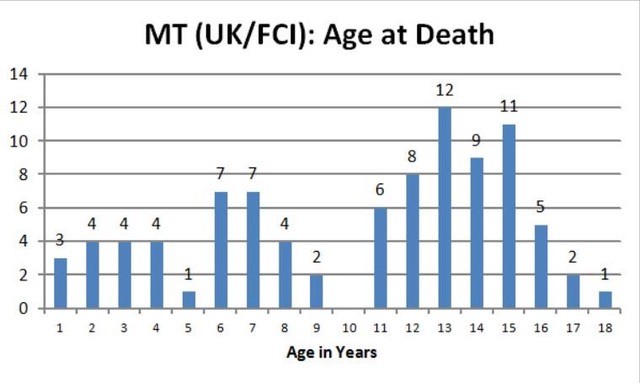
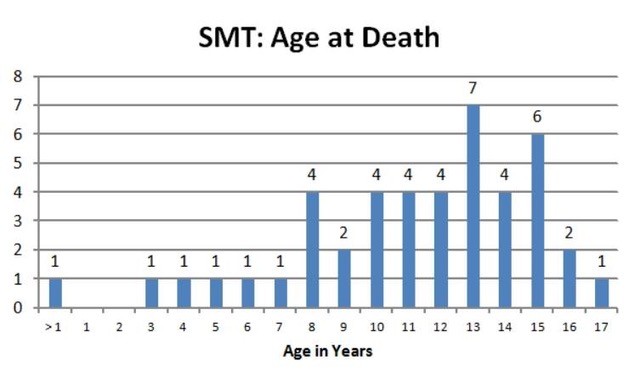
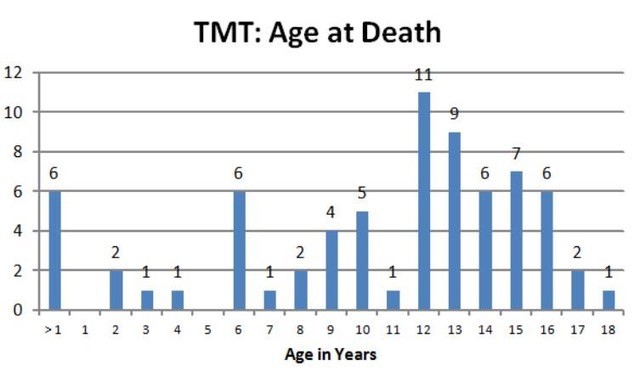
MITBESITZ / CO OWNER

In the spirit of friendly competition, we're issuing an Olympic-sized challenge to Manchester Terrier and English Toy Terrier breeders, owners and fanciers around the globe. Fill out a health survey from now to March 31st and show the world how much you love your favourite black and tans!
Let's see whose commitment to health will win the day... www.canadamt.com/surveys.html
Calling all Manchester Terrier and English Toy Terrier owners, former owners and breeders: The CMTC/AMTC General Health Survey is now open. If you currently own a Manchester Terrier or English Toy Terrier or if you owned one who died after January 1, 2002, we want to hear from you! By completing a simple, short survey about your dog's health, you can help us create the big picture view needed to ensure our black and tans stay happy and healthy. The survey takes less than 5 minutes to fill out and can be filled out multiple times by owners of multiple dogs. To learn more or to complete the survey, visit http://www.canadamt.com/surveys.html
The survey will remain open until February 28, 2018. Please help spread the word by liking and sharing!
A.Kelly
Manchester Terrier Weight: Part 2 (Breed Standard Comparisons)
The “bomb cyclone” provided some downtime to write this, so it seemed like a good time to move the discussion of Manchester Terrier weight along.
It was actually pointed out to me that as a Toy person (and a Canadian to-boot), perhaps I wasn’t entitled to an opinion on this subject at all. I do take the point, however I’d actually argue that both of those things might make it easier for me to facilitate a fact-based discussion of the topic. Certainly, those who are in the thick of it have many emotions at play, making it hard to divorce current events from the bigger picture questions that really need to be discussed.
I’d also point out that, like many things in life, the Canada-US relationship in this case is much like the mouse and the elephant. As we have already seen based on changes made to the US breed standard in the 1990s, any modifications to the American standard affect Canadian dogs because the genepool in our breed is so heavily based in the US. So, with that in mind I will (with apologies to critics), soldier on as I think this conversation is not only important for SMT breeders but to our entire breed.
With that out of the way, now that we have talked about WHY we use weight as a measurement tool in our breed, I thought it might be helpful to back up a step and look at three associated issues:
1) How size is determined across all breeds.
2) The nature and role of disqualifying faults.
3) The rules around weighing and measuring.
None of these topics is specific to Manchesters alone, in fact to have the most constructive conversation possible it’s important that we try to apply the principles that underlie each as widely as possible while also looking at their relationship to and affect on our breed.
So, let’s start with how size is determined generally in dogs. Here are a few points to think about:
A) Breed Standards as a Whole
For interest’s sake, I did a quick search through AKC breed standards. Now, my numbers jotted on the back of an envelope aren’t scientific but they should be somewhat close. I counted 179 AKC breed standards that specify either prescribed or suggested size ranges in inches, pounds or both. For the sake of brevity, where a breed standard applied to multiple varieties I just counted it once.
Of those 179 breed standards, 94 (53%) contain measurements pertaining to height only; 70 (39%) contain measurements pertaining to height and weight together; and 15 (8%) measure size using weight alone. 54 (30%) of the breed standards that specify a size or size range contain a disqualification for size.
Of the breed standards that contain DQs related to size, 50 (93%) measure size in terms of height and 4 (7%) determine size using weight alone.
Looking at the list of the 15 breeds whose breed standards specify only weight is interesting. These breeds include: Dachshunds, Greyhounds, Boston Terriers, Bulldogs, French Bulldogs, Border Terriers, Brussels Griffon, Chihuahua, English Toy Spaniels, Maltese, Manchesters, Pekingese, Pomeranians, Pugs and Yorkshire Terriers.
Among those breeds, the breed standards for Manchester Terriers, Chihuahuas, Pekingese and French Bulldogs contain disqualifications for size. The Manchester Terrier is the only breed in this group that was not developed as a companion.
![]() ???? Form for Function
???? Form for Function
A few breeds stand out to me when I look at the list of breeds using weight alone as their tool for determining size. For example, the Greyhound’s use of weight seems quite strange to given the breed’s history as a coursing breed (only Greyhounds and Dachshunds are measured by weight in the entire hound group). Looking at the breed standard does provide some clues as to why this may be the case though, and also raises some questions about early breed standards.
Barring formatting, the AKC and CKC Greyhound breed standards both read identically and neither bears an approved or effective date, which tells me that this is likely the breed standard that was in place when the two organizations were formed. Additionally, like the CKC’s Manchester breed standard the Greyhound standard contains a scale of points indicating where and how much emphasis should be placed on different aspects of conformation, providing another indication of its age (most of the point scales have been removed over the years but it was very common in old standards and can still be found in some today). Given weight is such a strange choice for a large breed like this, I wonder if it was simply more common when dog shows began to determine size using weight. It would certainly be very interesting to know if other breeds were originally measured by weight and switched to a height standard at some point (I hope those with other breeds will pipe in if they know!).
The inclusion of the Bulldog and Boston Terrier on the list of weight-based standards is also interesting to me given both share some form of relation genetically and functionally through the same blood sports that the Manchester Terrier breed standard references.
Certainly, we know Bulldogs were popular in bull baiting and were crossed with terriers for the purposes of related sports like rat baiting. Like Manchesters, Boston Terriers also descend from bull and terrier crosses and were themselves used for pit ratting purposes. So the fact that Bulldogs and Bostons continue to use weight is not surprising, though it is notable that neither has an associated disqualification. Just as interesting, however, is the fact that the Bull Terrier, which was developed in parallel with the Manchester, has no reference in their breed standard to size at all.
OK, I’ll stop here—hopefully there are some things to chew on above and I hope others will pipe in.
I’m sure everyone will read something different into the above, but here are my takeaways after having read so many standards:
a) It is very uncommon in the context of modern dog shows for a breed standard to use weight alone as a measurement for size.
b) It is very rare to use weight as the basis for disqualifying a dog, with just 4 breeds (2%) among all of the breed standards I looked at citing weight as a disqualifying fault. Three of those breeds were developed as companions.
c) It is possible that weight was a more common tool for measurement when breed standards were originally written (please chime in if you have info to add).
d) Some of the breeds whose breed standards continue to use weight alone are related historically to Manchesters, either through ancestry or use in similar functions.
Amanda Kelly
Ch. Queensbury Surprise in 1920 ![]() ????
????
![]() ????????《Manchester Terrier》
????????《Manchester Terrier》
